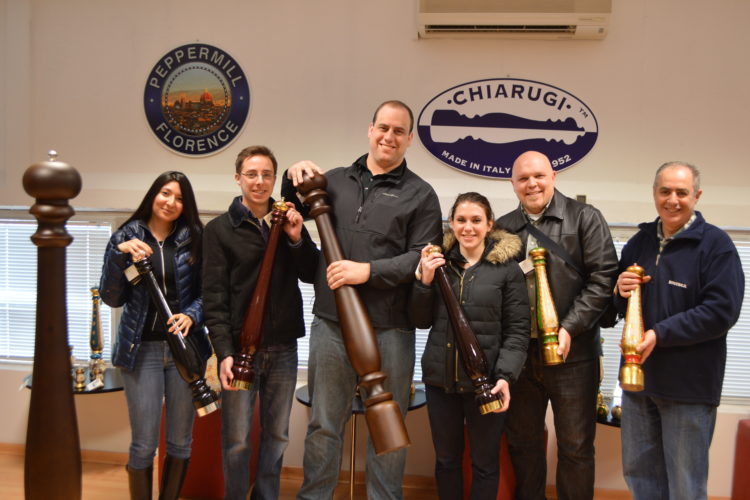On the windiest day in memory in Florence, we survived blown over trees, vespas, and errant cups of coffee to make our way to the heart of the Florentine handicraft industry. As part of the CEL Artex Practicum project, we traveled to three manufacturers, IVV, Chiarugi, and Capecchi Home Linens today, and were given the opportunity to tour their facilities and speak with their management.
 The first company, IVV, is the largest glass manufacturer in Europe. They make the majority of their products completely by hand, and the results were quite impressive. The company makes large vases, colorful flowers, and nearly any tabletop object imaginable. The factory itself was also a sight to be seen; Professor Sergio Chayet would have refused to leave if he had been here.
The first company, IVV, is the largest glass manufacturer in Europe. They make the majority of their products completely by hand, and the results were quite impressive. The company makes large vases, colorful flowers, and nearly any tabletop object imaginable. The factory itself was also a sight to be seen; Professor Sergio Chayet would have refused to leave if he had been here.
We were also able to obtain insights into the glass making process, as well as the challenges facing the glass industry in Italy. IVV had once supplied well known chains such as Crate & Barrel, but its customers have yet to fully return following the 2007 financial crisis. Following conversations with the company’s representatives, it seems that the company plans to target smaller boutiques abroad while it slowly regains its business partnerships with larger entities.
Following our trip to IVV, we made our way to Chiarugi, a maker of intricate, high-end salt and pepper mills. (see photo above) Chiarugi makes many different styles and guarantees its internal components for life. The factory was small but the workers were lively and very helpful.
Currently, the vast majority of the company’s customers are luxury hotels and restaurants. As it products are made at a very high quality, once it makes a sale follow-up orders are usually updates or replacements and are thus hard to predict. The company, therefore, wants to get more involved in selling to consumers via retail stores, specifically targeting the United States. We had the chance to brainstorm some strategies with one of the company’s owners, and we hope that the successful completion of our project with Artex will transform their plans into reality.
 Our final visit was to Capecchi Home Linens, located in Pistoia. The company has been in the same family for three generations and we had the opportunity to tour the facility with its current owner. The company imports high quality cotton from Egypt and the Middle East, and then dyes, embroiders, and finishes the sheets, pillow cases, and other linen goods in house.
Our final visit was to Capecchi Home Linens, located in Pistoia. The company has been in the same family for three generations and we had the opportunity to tour the facility with its current owner. The company imports high quality cotton from Egypt and the Middle East, and then dyes, embroiders, and finishes the sheets, pillow cases, and other linen goods in house.
 The company produces only when orders come in, and they offer their customers the ability to customize the products to a large degree. Speaking with the owner after the tour, he indicated that he does not want to become a high volume producer like some manufacturers in China. In fact, his goal was simply to add one new customer per year, so long as this customer builds a relationship with him.
The company produces only when orders come in, and they offer their customers the ability to customize the products to a large degree. Speaking with the owner after the tour, he indicated that he does not want to become a high volume producer like some manufacturers in China. In fact, his goal was simply to add one new customer per year, so long as this customer builds a relationship with him.
The overall goal of our project is essentially to introduce small, high end retailers directly to manufactures in Italy, allowing the former to obtain wholesale prices and the latter to create business relationships in the United States.
Overall, the day was a success. Through adverse conditions, we were able to round out our understanding of the handicrafts industry in Tuscany. We have no doubt that our Center for Experiential Learning (CEL) project will be put into much sharper focus when we return to the United States so that we can deliver results to Artex by the end of the semester.



